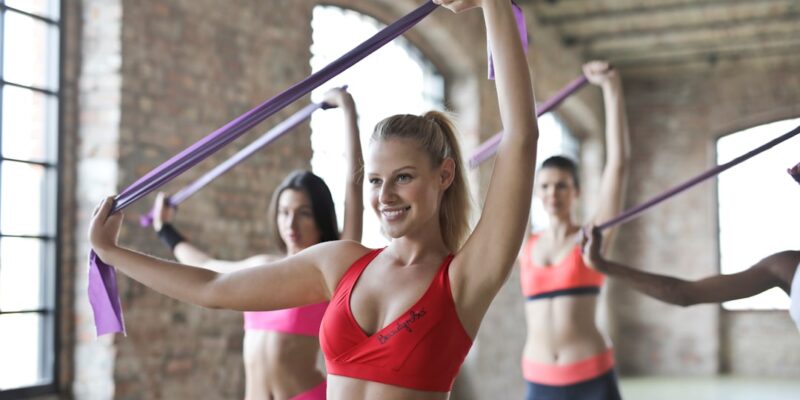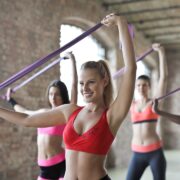
Zumba: Fun & Fitness in One Workout!
Zumba has taken the fitness world by storm, becoming one of the most popular workout programs in recent years. This high-energy dance fitness class combines Latin and international music with easy-to-follow dance moves, making it a fun and effective way to get fit. In this blog post, we will explore what Zumba is, how it works, and the many benefits it offers for both your body and mind. Whether you’re a beginner looking to get started or a seasoned Zumba enthusiast, this article will provide you with all the information you need to know about this exciting workout program.
Key Takeaways
- Zumba is a dance fitness program that combines Latin and international music with dance moves.
- Zumba can improve cardiovascular health, increase endurance, and boost mood and self-esteem.
- Zumba can help with weight loss and toning by burning calories and targeting specific muscle groups.
- Beginners can start with a basic Zumba class and gradually work their way up to more advanced classes.
- There are different types of Zumba classes, such as Aqua Zumba and Zumba Toning, to cater to different fitness goals and preferences.
What is Zumba and How Does it Work?
Zumba is a dance fitness program that was created in the 1990s by Colombian dancer and choreographer Alberto “Beto” Perez. It combines elements of dance and aerobics to create a fun and engaging workout experience. The word “Zumba” comes from a Colombian slang term meaning “to move fast and have fun.” The program incorporates various dance styles, including salsa, merengue, cumbia, reggaeton, and hip-hop, as well as international rhythms such as belly dancing and African beats.
Zumba works by combining high-intensity cardio exercises with resistance training to provide a full-body workout. The choreography is designed to target different muscle groups, improve cardiovascular endurance, and increase flexibility. Each Zumba class typically lasts for about an hour and consists of a warm-up, several dance routines, and a cool-down period. The routines are easy to follow, making Zumba accessible to people of all fitness levels.
The Benefits of Zumba for Your Body and Mind
Zumba offers numerous benefits for both your body and mind. On the physical side, Zumba is a great way to improve cardiovascular health. The high-energy dance moves get your heart rate up, helping to strengthen your heart and lungs. Regular Zumba workouts can also lead to weight loss, as the combination of cardio and resistance training helps to burn calories and build lean muscle mass. Additionally, Zumba can help to tone and sculpt your muscles, particularly in the legs, core, and arms.
In addition to the physical benefits, Zumba also has several mental health benefits. The upbeat music and energetic atmosphere of a Zumba class can help to relieve stress and improve mood. The release of endorphins during exercise can also boost feelings of happiness and reduce symptoms of anxiety and depression. Furthermore, participating in Zumba can increase self-confidence and body positivity. As you learn new dance moves and improve your fitness level, you may feel a sense of accomplishment and pride in your abilities.
How Zumba Can Help You Lose Weight and Tone Your Muscles
| Benefits of Zumba | Description |
|---|---|
| Cardiovascular Health | Zumba is a high-energy workout that can improve your heart health and reduce the risk of heart disease. |
| Weight Loss | Zumba can help you burn calories and lose weight, especially when combined with a healthy diet. |
| Muscle Toning | Zumba involves a lot of movement and can help tone your muscles, especially in your legs, glutes, and core. |
| Improved Coordination | Zumba involves a lot of dance moves and can help improve your coordination and balance. |
| Stress Relief | Zumba is a fun and energetic workout that can help reduce stress and improve your mood. |
Zumba is an effective workout for weight loss and muscle toning due to its combination of cardio and resistance training. The high-intensity dance moves in Zumba classes can burn a significant number of calories, helping you to create a calorie deficit and lose weight. According to the American Council on Exercise, a one-hour Zumba class can burn between 400-600 calories, depending on factors such as intensity level and body weight.
In addition to calorie burning, Zumba also incorporates resistance training through bodyweight exercises. Moves such as squats, lunges, and arm movements help to strengthen and tone muscles throughout the body. For example, salsa-inspired moves can target the legs and glutes, while belly dancing-inspired moves can engage the core muscles. By regularly participating in Zumba classes, you can build lean muscle mass and achieve a more toned physique.
Zumba for Beginners: Tips and Tricks to Get Started
If you’re new to Zumba, it’s important to start slowly and gradually increase your intensity level as you become more comfortable with the moves. Here are some tips for beginners:
1. Wear comfortable clothing and supportive shoes: Choose workout clothes that allow for ease of movement and moisture-wicking fabric to keep you cool and dry. Invest in a pair of supportive athletic shoes that provide cushioning and stability.
2. Hydrate before, during, and after class: Zumba is a high-energy workout that can make you sweat a lot. Make sure to drink plenty of water before, during, and after your class to stay hydrated.
3. Listen to your body: If you’re feeling tired or experiencing pain, take a break or modify the moves as needed. It’s important to listen to your body and not push yourself too hard, especially when you’re just starting out.
4. Find a class that suits your fitness level: Look for beginner-friendly Zumba classes or classes labeled as “low-impact” or “easy” to start with. These classes typically have slower-paced routines and provide modifications for beginners.
5. Have fun and don’t worry about getting the moves perfect: Zumba is all about having fun and enjoying the music. Don’t worry if you don’t get the moves exactly right at first. Just keep moving and have a good time!
To find a Zumba class near you, check with local gyms, community centers, or dance studios. Many fitness facilities offer Zumba classes as part of their group exercise schedule.
The Different Types of Zumba Classes and Which One is Right for You
Zumba offers a variety of different class formats to cater to different fitness levels and preferences. Here are some of the most popular types of Zumba classes:
1. Zumba Fitness: This is the original Zumba class format that combines Latin and international music with easy-to-follow dance moves. It is suitable for all fitness levels and focuses on cardio endurance and overall body toning.
2. Zumba Toning: This class incorporates light hand weights or toning sticks to add resistance to the dance moves. It is designed to target specific muscle groups and provide a more intense strength training workout.
3. Aqua Zumba: This class takes place in a pool and combines Zumba moves with water resistance. It is a low-impact workout that is gentle on the joints, making it suitable for people with joint pain or injuries.
4. Zumba Gold: This class is specifically designed for older adults or those with limited mobility. It features modified moves and lower intensity levels to accommodate different fitness levels.
When choosing a Zumba class, consider your fitness level, goals, and preferences. If you’re new to Zumba or have any health concerns, it’s always a good idea to consult with your doctor before starting any new exercise program.
Zumba for Kids: A Fun Way to Get Active and Stay Healthy
Zumba is not just for adults – it’s also a great way for kids to get active and stay healthy. In fact, there are specialized Zumba classes designed specifically for children. Here are some of the benefits of Zumba for kids:
1. Improved physical fitness: Zumba helps children improve their cardiovascular endurance, strength, flexibility, and coordination. The high-energy dance moves get kids moving and provide a fun way to stay active.
2. Boosted self-confidence: Participating in Zumba can help children build self-confidence and improve body image. As they learn new dance moves and improve their fitness level, they may feel a sense of accomplishment and pride in their abilities.
3. Social interaction: Zumba classes provide an opportunity for children to interact with their peers in a fun and supportive environment. They can make new friends, develop teamwork skills, and build a sense of community.
If you’re interested in getting your child involved in Zumba, look for classes specifically designed for kids or family-friendly classes that allow children to participate alongside their parents. You can also find Zumba videos or online classes that are suitable for children.
Zumba for Seniors: Low-Impact Moves for a Safe and Effective Workout
Zumba is a great workout option for seniors, as it can be modified to accommodate different fitness levels and physical abilities. Here are some of the benefits of Zumba for seniors:
1. Improved cardiovascular health: Zumba can help seniors improve their cardiovascular endurance and strengthen their heart and lungs. The low-impact dance moves are gentle on the joints, making it a safe option for those with arthritis or other joint conditions.
2. Increased flexibility and balance: Zumba incorporates a variety of dance moves that can help seniors improve their flexibility and balance. This can be particularly beneficial in reducing the risk of falls and maintaining independence as they age.
3. Social interaction: Participating in Zumba classes can provide seniors with an opportunity to socialize and connect with others in their community. It can help combat feelings of loneliness and isolation, which are common among older adults.
Seniors who are interested in trying Zumba should look for classes specifically designed for older adults or classes labeled as “low-impact” or “gentle.” It’s important to listen to your body and modify the moves as needed to ensure a safe and effective workout.
The Social Benefits of Zumba: Making Friends and Having Fun
One of the unique aspects of Zumba is its ability to create a sense of community and foster friendships. Zumba classes provide an opportunity to meet new people, connect with others who share similar interests, and have fun together. Here are some ways that Zumba can be a social activity:
1. Group atmosphere: Zumba classes are typically done in a group setting, with participants following the instructor’s moves together. This creates a sense of camaraderie and support among class members.
2. Dance partners: Some Zumba routines involve partnering up with another class member. This can be a fun way to interact with others and build connections.
3. Zumba events and parties: Zumba instructors often organize special events or parties where participants can come together to dance, socialize, and have fun. These events can be a great way to meet new people and expand your social circle.
If you’re looking to make friends and have fun while getting fit, Zumba is a great option. Don’t be afraid to strike up a conversation with your fellow class members and get to know them outside of the workout setting.
Zumba at Home: How to Create Your Own Zumba Workout Routine
If you prefer to work out at home or don’t have access to a Zumba class in your area, you can still enjoy the benefits of Zumba by creating your own workout routine. Here are some tips for creating a Zumba workout at home:
1. Find online Zumba videos: There are many free Zumba workout videos available online that you can follow along with at home. Look for videos that are suitable for your fitness level and preferences.
2. Clear a space: Make sure you have enough space in your home to move around freely without any obstacles. Clear away furniture or other items that may get in the way.
3. Warm up and cool down: Just like in a regular Zumba class, it’s important to warm up your muscles before starting your workout and cool down afterward. Spend a few minutes doing light cardio exercises and stretching before and after your workout.
4. Set a schedule: Treat your at-home Zumba workouts like any other workout session by scheduling them into your weekly routine. Aim for at least three to four sessions per week to see results.
5. Have fun and stay motivated: Remember that the most important thing is to have fun and enjoy yourself during your at-home Zumba workouts. Play your favorite music, dance like nobody’s watching, and stay motivated by setting goals and tracking your progress.
The Future of Zumba: Trends and Innovations in the World of Dance Fitness
As the fitness industry continues to evolve, so does Zumba. The program has adapted to stay relevant and innovative by incorporating new trends and technologies. Here are some current trends in the world of dance fitness:
1. Virtual classes: With the rise of online fitness platforms, virtual Zumba classes have become increasingly popular. These classes allow participants to join in from the comfort of their own homes and follow along with an instructor via a live stream or pre-recorded video.
2. Wearable technology: Many fitness enthusiasts are using wearable devices such as fitness trackers or smartwatches to monitor their workouts and track their progress. Zumba has embraced this trend by incorporating wearable technology into its classes, allowing participants to track their heart rate, calories burned, and other metrics.
3. Fusion classes: Zumba has started to incorporate other fitness disciplines into its classes to provide a more diverse workout experience. For example, Zumba Strong combines high-intensity interval training (HIIT) with dance moves, while Zumba Step incorporates step aerobics into the routines.
4. Zumba for special populations: Zumba has expanded its offerings to cater to specific populations, such as pregnant women, postpartum moms, cancer survivors, and individuals with disabilities. These specialized classes provide modified moves and additional support for these populations.
Zumba is not just a workout – it’s a lifestyle that can transform your body and mind. Whether you’re looking to lose weight, tone your muscles, improve your cardiovascular health, or simply have fun while getting fit, Zumba offers something for everyone. From beginners to seniors, kids to adults, there is a Zumba class that can cater to your fitness level and goals.
So why not give Zumba a try? Find a class near you, put on your dancing shoes, and get ready to move and groove to the beat. You’ll be amazed at the physical and mental benefits that Zumba can provide. So go ahead, join the Zumba revolution and experience the joy of dance fitness for yourself!
FAQs
What is Zumba?
Zumba is a dance fitness program that combines Latin and international music with dance moves. It was created in the 1990s by Colombian dancer and choreographer Alberto “Beto” Perez.
What are the benefits of Zumba?
Zumba is a fun and effective way to improve cardiovascular health, burn calories, and tone muscles. It can also improve coordination, balance, and flexibility.
Is Zumba suitable for beginners?
Yes, Zumba is suitable for beginners as well as advanced exercisers. The dance moves can be modified to suit different fitness levels and abilities.
What should I wear to a Zumba class?
Wear comfortable workout clothes and supportive athletic shoes. Avoid loose clothing that may get in the way during the dance moves.
Do I need any equipment for Zumba?
No, you do not need any equipment for Zumba. Just bring a water bottle and a towel to wipe off sweat.
How long is a typical Zumba class?
A typical Zumba class is usually 60 minutes long, but some classes may be shorter or longer.
Can Zumba help me lose weight?
Yes, Zumba can help you lose weight by burning calories and increasing your metabolism. However, weight loss also depends on your diet and overall lifestyle habits.
Is Zumba safe for people with injuries or health conditions?
It is important to consult with your doctor before starting any new exercise program, especially if you have injuries or health conditions. Zumba can be modified to suit different needs, but it is important to listen to your body and avoid any movements that cause pain or discomfort.


















